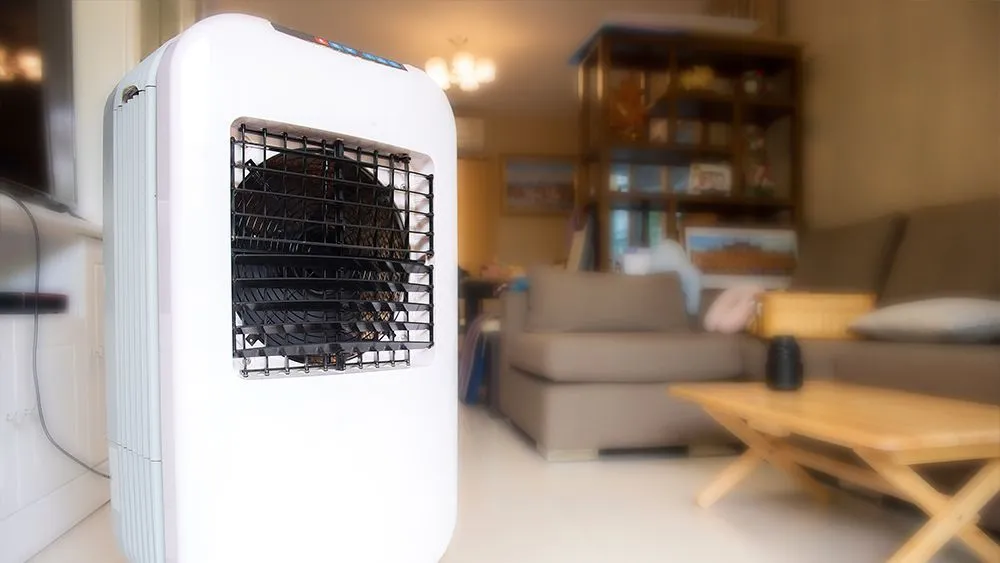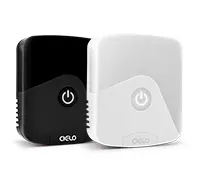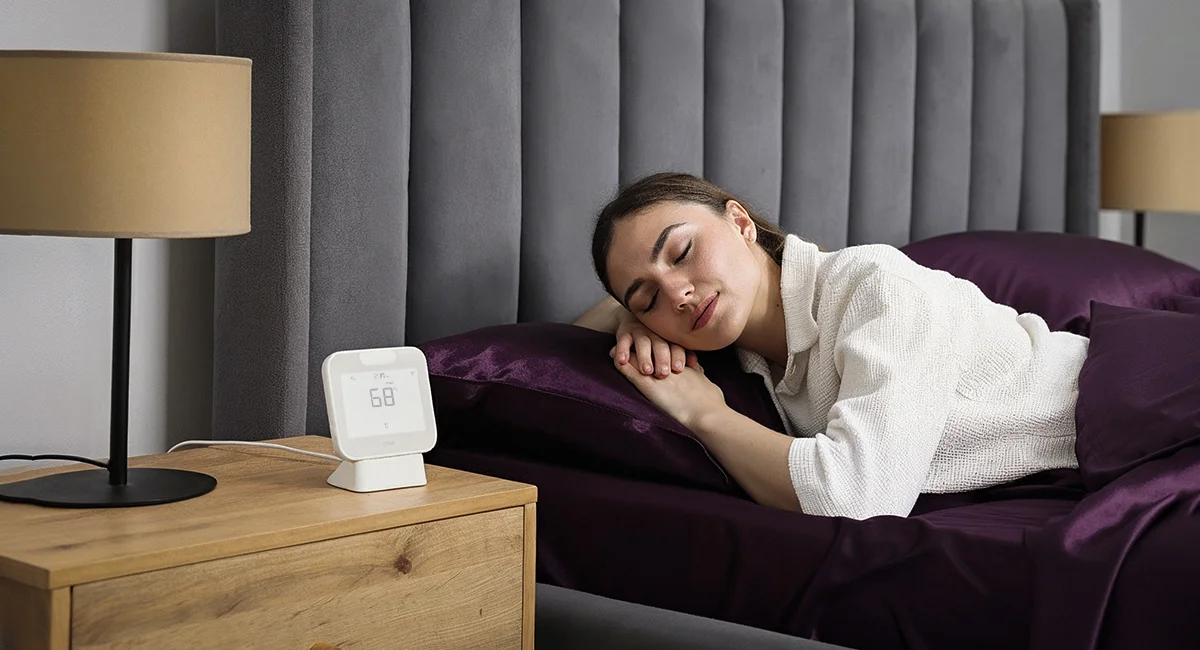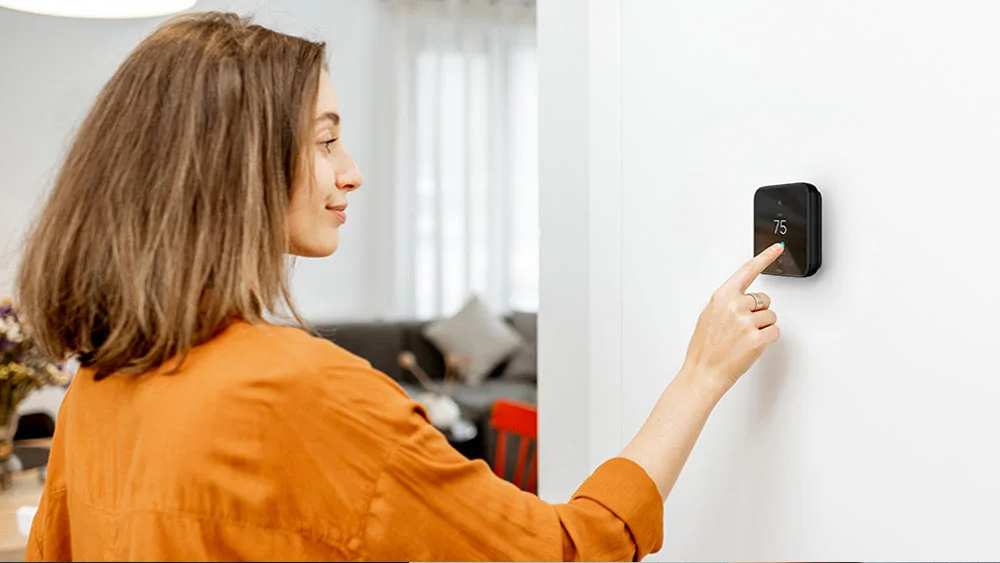
Key Takeaways
- Mini-split, through-the-wall, and portable AC units are great air conditioner options for a room with no windows.
- Use a ceiling fan to boost air circulation and create a cooling effect.
- Planting trees and shrubs outside a windowless room can naturally cool the interior by providing shade.
A windowless basement, office space, or a garage – there are plenty of situations where you are stuck in a room without windows. You may have noticed that the air feels stuffy, as there’s no natural ventilation that occurs through windows.
Fortunately, there are plenty of ways to cool down a room with no windows. You can employ modern cooling technology and smart lifestyle adjustments to create a comfortable environment in your windowless room.
- 1. Go for a Mini-Split AC
- 2. Install a Through-the-Wall Air Conditioner
- 3. Buy a Portable AC
- 4. Incorporate Smart Technology
- 5. Use an Evaporative Cooler
- 6. Use a Floor Fan & Ice Cubes
- 7. Use the Two Fan Method
- 8. Ceiling Fan
- 9. Turn on the Exhaust Fan
- 10. Replace Your Incandescent Lights
- 11. Cover Your Furniture With Light Sheets
- 12. Make Use of Landscaping
- 13. Reduce Your Body Temperature
- 14. Keep Appliances Off When Not in Use
- Wrapping It Up
- Frequently Asked Questions
1. Go for a Mini-Split AC
Mini-split systems operate without ducts and are very efficient in cooling spaces without windows.
They have two units; the indoor unit introduces cool air into your room, while the outdoor unit ejects the unwanted heat. Installation only requires a small hole – a mere three inches in the wall, leaving a very quick and not very invasive procedure.
Key Benefits:
- Mini-splits are energy-efficient air conditioners; there is minimal heat loss as they deliver air straight from the unit to the focused area.
- You can pair up your mini-split AC with a smart thermostat to make your unit smart.
2. Install a Through-the-Wall Air Conditioner
Unlike conventional window air conditioner, through-the-wall AC is designed to fit in a wall opening, making it an appropriate device for a windowless room.
The installation requires a hole to be opened in the wall, which is a bit of a hassle. You would have to select an exterior wall with plenty of open space around it and make sure there is no plumbing or electrical wiring inside it.
Key Benefit:
- They are more energy efficient when compared to window ACs. The difference occurs due to their installation method. Windows ACs are installed in the window frames, which tend to have gaps, leaking cool air. The wall air conditioners perfectly fit into the wall, preventing air leakage
3. Buy a Portable AC
Portable air conditioners provide a simple solution to cool rooms that do not have windows. They are small, compact, easy to install, and move around, hence becoming increasingly popular.
Portable units require a hose to vent hot air, and windows are a frequent outlet. However, in a windowless room, you will need to drill holes in an exterior wall, which is a semi-permanent solution rather than a temporary one.
Key Benefits:
- It can be moved from room to room as needed.
- These ACs also remove moisture, which helps keep your room comfortable during hot, humid days.
- Dual-hose models are more energy efficient because they offer fresh outdoor air to the system, thereby relieving the load.
4. Incorporate Smart Technology
Cooling a windowless room can get tricky, so having a smart device to automate your room climate can be super helpful. You can use a smart thermostat for mini-splits that work with mini-splits and other room units like portable ACs or through-the-wall air conditioners.
- You control your air conditioner using your phone, even when you’re away. This is especially useful in windowless rooms where heat builds up fast and needs active management.
- You can set daily or weekly schedules to align with your routine. Automate cooling to kick in before you enter the room or turn off when you leave. This ensures the space stays cool without wasting energy.
- Cielo Breez Max, a mini-split thermostat, has a Comfy Max feature that works by intelligently adjusting your AC settings to maintain your preferred room temperature without overheating or overcooling.
Your best choice to make any mini-split, window,
or portable AC smart. Enhance your comfort and savings.

5. Use an Evaporative Cooler

Evaporative coolers, also commonly called swamp coolers, offer a great solution for cooling a windowless room.
These coolers have tanks where you can add cold water or ice. They work by passing air over the cold water, and the resulting chilled air is then circulated throughout the room.
While using an evaporative cooler, it is necessary to leave the door open to push warm air outside. Evaporative coolers work best in low-humidity areas.
Key Benefits:
- There is no lengthy setup process. You just have to plug in the cooler and fill it with cold water or ice.
- Evaporative coolers consume less energy than air conditioners.
6. Use a Floor Fan & Ice Cubes
Using a floor fan and ice cubes is a simple and effective way to cool down a windowless room without relying on complex installations or expensive equipment. It’s a budget-friendly solution that can bring quick relief on a hot day.
- Fill a large bowl with ice cubes.
- Place the bowl of ice directly in front of your floor fan.
- Turn on the fan to blow air across the ice. As the ice melts, it will cool the air, and the fan will circulate the cool air throughout the room.
Key Benefits:
- The ice absorbs heat as it melts, creating a refreshing, cool breeze when combined with the fan.
- The fan helps distribute this cool air evenly across the room, improving comfort during hot weather.
Tip: Close the doors to keep the cold air trapped inside your windowless room, ensuring the cooling effect lasts longer.
7. Use the Two Fan Method
The two-fan method is a simple, non-permanent way to cool a windowless room, ideal for short-term living situations. While it may not offer the same cooling power as an air conditioner, it can still help improve air circulation and reduce the heat in your space.
You need two fans pointed in a specific direction to make this method work.
- Position one fan to face the ceiling. This fan will help circulate the air around the room.
- Place the second fan near the door, directing it outward to push the hot air out of the room.
Key Benefit:
- The fan aimed at the ceiling helps prevent the air from becoming stagnant, while the second fan actively expels warm air, creating a cross-flow of air to reduce the room temperature.
8. Ceiling Fan
Installing a ceiling fan is a simple and affordable way to help cool a room without windows. While fans don’t directly lower the temperature, they keep the air circulating, which creates a cooling effect.
In summer, your fans should be rotating in a counterclockwise direction to push the cool air down.
Key Benefits:
- Ceiling fans use less energy than air conditioners, making them a budget-friendly option for cooling a room without windows.
- Using a ceiling fan in combination with your AC allows you to set the temperature a few degrees higher without sacrificing comfort, leading to reduced energy consumption.
9. Turn on the Exhaust Fan
If your room doesn’t have windows, an exhaust fan can be an effective way to remove hot air from the space.
If you don’t want it installed inside your room, you can still benefit from your bathroom’s exhaust fan. You just need to turn on the exhaust fan and leave the bathroom door open. The fan will pull the hot air out of your room and release it outside.
The exhaust fan method is most effective when the outside temperature is lower than the inside temperature. If the outside air is hot, it won’t help in cooling down the room.
10. Replace Your Incandescent Lights
You might be surprised to learn that the type of lighting in your room can contribute to its overall temperature. Incandescent bulbs, in particular, generate a lot of heat, which can exacerbate the warmth in a windowless room with little ventilation. They release about 90% of their energy as heat.
Consider replacing your incandescent bulbs with LED lights. They do not give off heat and won’t increase your room’s temperature. They are also more energy-efficient and cost considerably less.
11. Cover Your Furniture With Light Sheets
Furniture fabric like leather, velvet, or polyester can trap and radiate heat. Cover your sofas with cotton sheets. Avoid heat-trapping materials like fleece or flannel.
12. Make Use of Landscaping

Even without direct sunlight, a windowless room can still get warm due to solar heat gain through the roof and walls. One smart way to reduce this heat is through landscaping around the room’s exterior.
According to the U.S. Department of Energy, strategic landscaping like planting trees and shrubs can reduce surrounding temperatures by up to 6°F, which helps in keeping interior spaces cooler, too.
- Plant deciduous trees that offer shade in the summer and allow sunlight through in the winter.
- Use shrubs and groundcover plants to lower the temperature around the base of your room.
- Grow climbing vines on walls as they act like natural insulation, preventing heat buildup on exterior walls.
13. Reduce Your Body Temperature
If installing an AC isn’t an option, these simple techniques can help lower your body temperature and keep you comfortable.
- Drink cool water or hydrating juices throughout the day. Cold liquids help lower your core body temperature.
- Place an ice pack or cold compress on areas like your wrists, neck, or temples. These spots have blood vessels close to the surface, so cooling them helps cool your entire body faster.
- Choose lightweight materials like cotton or linen. They wick away moisture and let heat escape more easily than synthetics.
14. Keep Appliances Off When Not in Use
Every electronic device in your room gives off heat when it’s powered on, even if you’re not actively using it. While one gadget might not make a big difference, multiple devices running at once can noticeably raise the temperature, especially in a room without windows or proper ventilation.
Unless you are using your computer or television, these devices should be turned off. Switching off lights when not in use and keeping appliances like the iron out of the room can significantly reduce the amount of heat that builds up in a windowless room.
Wrapping It Up
With the right approach, a windowless room can be a space you enjoy, no matter how hot it gets outside. Make use of these strategies and transform your windowless room into a haven of comfort, with or without direct sunlight.
Frequently Asked Questions
Windows help provide fresh airflow while removing the hot, stale air from your room. In a windowless room without any proper source of ventilation, heat gets trapped with nowhere to escape. Yes, placing ice in front of a fan can help cool the air temporarily as the fan blows the chilled air around the room. To get airflow in a room without windows, you can use a combination of fans. Ceiling or floor fans help circulate air, while exhaust fans can remove stale air.
Why Is a Windowless Room Hot?
Does Putting a Bowl of Ice in a Room Cool It Down?
How to Get Airflow in a Room Without Windows?








